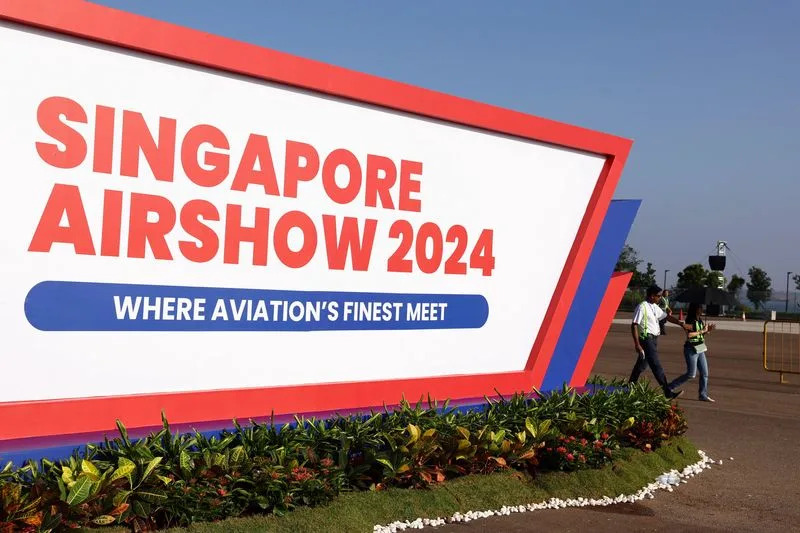China unveils export version of attack helicopter

China this week unveiled the export version of the signature attack helicopter by the People’s Liberation Army at the Singapore Airshow here.
Though China has participated in the biennial airshow in previous years, this marks the first time Chinese state-owned companies displayed a military aircraft in an airshow outside the country.
China unveiled the Z-10ME at Airshow China 2021; some analysts have since compared it to Boeing’s AH-64 Apache.
The PLA has used the helicopter for military exercises near Taiwan and India. More than 200 Z-10s and its numerous variations are in active service with the PLA, according to the Military Balance 2023 report from the International Institute for Strategic Studies think tank.
The attack helicopter was developed by Changhe Aircraft Industries and brought to the airshow by state-owned China National Aero-Technology Import & Export Corp. and the Aviation Industry Corporation of China.
At this year’s Singapore Airshow, the company displayed the export version, known as the Changhe Z-10-ME-02, alongside rocket launchers, GR5 guided rockets and air-to-air missiles CM-502KG and TY-90. Chinese delegates have not granted interviews or scheduled any media briefings about the helicopter.
The helicopter can carry 23mm high-explosive incendiary ammunition and a 280kg drop tank. The aircraft is equipped with a mast-mounted radar, a missile approach warning system, and directional infrared countermeasure systems against heat-seeking (IR) missiles, according to Flight Daily News, the airshow’s magazine.
Previous iterations of the Changhe Z-10 have carried air-to-surface and larger air-to-air missiles such as the AIM-9 Sidewinder.
Aside from China, the aircraft is being used by the Pakistan military. In 2022, Pakistan Army spokesperson Maj. Gen. Babar Iftikhar announced government plans to procure Z-10ME attack helicopters to replace a previously signed deal for T129 attack helicopters from Turkey.
While the government has not disclosed the number of helicopters ordered and the price, the Pakistan military reportedly received initial batches of the Z-10ME last year.
Boeing declines to send passenger planes to Singapore Airshow
A Boeing 777-9, commercial jet sits on the tarmac during a layover at St. Louis-Lambert International Airport in St. Louis on June 26, 2023. Boeing said it will not send a passenger plane to the Singapore Airshow this week.
The Singapore Airshow opened Monday without a showing of Boeing commercial airplanes while China displayed its own airliner, which it hopes will one day compete with the American aviation giant and Airbus.
Boeing will not show any commercial airplanes at the airshow because of its current safety investigation that started last month after a door plug blew off one of its passenger planes operated by Alaska Airlines on Jan. 5.
Boeing, though, will still have a footprint on the airshow, which runs through Sunday. It will showcase its military fighters that will be part of the U.S. Air Force display. It will invite visitors to see a cabin display of its widebody 777X, the world's largest twin-engine passenger plane.
"We are proud to once again participate at the Singapore Airshow, which highlights how Southeast Asia's fast-growing economies continue to invest in new aerospace products and services for the future," Brendan Nelson AO, president of Boeing Global said in a statement earlier this month.
"Boeing provides our commercial and government customers across the region with the capabilities they need while we continue to expand our regional presence and open new opportunities for our partners and suppliers."
Boeing will have representatives from its sustainability sectors, defense, and STEM as well.
China's passenger airplane C919, which carries under 200 passengers, will make its debut on behalf of Beijing's Commercial Aircraft Corporation of China. While certified to only fly in China, officials there hope one day that its passenger planes can one day compete on a larger stage.
Chinese jet C919 makes its debut at Singapore Airshow
Chinese manufacturers hope the C919 jet, which made its debut at The Singapore Airshow on Tuesday, could help the country catch up to producers like Boeing and Airbus.
Chinese manufacturers hope the C919 jet, which made its debut at the Singapore Airshow on Tuesday, can help the country catch up to producers like Boeing and Airbus.
After decades of lagging behind the U.S.In terms of aircraft manufacturing, China has invested heavily to produce a new aircraft.
The C919, made by Commercial Aircraft Corporation of China, carries just under 200 passengers. Currently, the aircraft is only certified to fly in China through China Eastern Airlines.
In an interview with South China Morning Post, Liu Daxiang, deputy director of the science and technology committee at the Aviation Industry Corporation of China (Avic), said China has previously lacked experience developing a commercial aviation engine.
Shukor Yusof, founder of Endau Analytics, a firm that tracks the aviation industry, told CNN the C919 would be "the most scrutinized aircraft" at the Singapore Airshow.
Boeing announced it would be skipping the show this week due to continued manufacturing issues.
Singapore air show kicks off with orders for China's COMAC, Boeing
Singapore on Tuesday kicked off Asia's biggest aviation gathering with orders for China's COMAC and Boeing planes as the industry grapples with a rebound in post-pandemic travel demand in the face of severe supply constraints.
More than 1,000 companies from more than 50 countries are participating in the biennial commercial and defence-focused Singapore Airshow, led by Western industry giants such as Airbus, Boeing and Lockheed Martin and their Chinese competitors such as COMAC and AVIC.
Russian companies such as Russian Helicopters and Irkut that attended past editions of the show are not participating this year amid the war in Ukraine. However, Israeli companies Israel Aerospace Industries and Rafael Advanced Defense Systems, which dropped out of the Dubai Airshow in November amid the Israel-Hamas war in Gaza, are in attendance.
Trade delegates donned hats and sunglasses on a hot, clear day to watch flying displays featuring military aircraft from Singapore, Australia, India, Indonesia, South Korea and the United States, as well as the COMAC C919 commercial jet and an Airbus A350-1000 powered by 35% sustainable aviation fuel.
COMAC, which brought its self-developed C919 narrow-body jet outside Chinese territory for the first time to the show, posted the first aircraft orders of the event on Tuesday morning, with China's Tibet Airlines finalising an order for 40 C919 single-aisle planes and 10 ARJ21 regional jets, and China's Henan Civil Aviation Development and Investment Group ordering 6 ARJ21s.
Royal Brunei Airlines later announced a firm order for four Boeing 787-9 Dreamliners, while the U.S. planemaker also held a signing ceremony to mark a recently placed order for 45 of the wide-body planes by Thai Airways.
Given its timing early in the year, there are typically fewer major order announcements at the Singapore air show than at its counterparts in Paris, Farnborough and Dubai.
By the end of 2023, travel demand had made a near-full recovery from pre-pandemic levels in 2019, with domestic travel running 4% higher than pre-COVID levels and the international market lagging at 88% mostly because of China's slower rebound, according to International Air Transport Association data.
"We see 2024 as a real return to normal," said Steven Townend, the CEO of Singapore-based aircraft lessor BOC Aviation. "The industry is growing, airlines are making money again on a global basis. For 2024, we're really positive."
SUPPLY CHAIN STRUGGLES
Major suppliers, planemakers and engine producers have struggled to keep up with the rebound in demand after the sharp downturn during COVID-19 led to job losses, freight snarls and an industry skills shortage.
Boeing, in particular, is under scrutiny after the mid-air blowout of a cabin panel on an Alaska Airlines 737 MAX on Jan. 5 led the U.S. Federal Aviation Administration to take the unprecedented step of freezing production of its best-selling single-aisle plane at 38 per month.
Airbus this month announced a further delay in entry to service of its long-range A321XLR single-aisle jet to the third quarter from the second. Suppliers told Reuters that Airbus is producing about 50 A320neo family jets a month compared with a production plan that had foreseen 58 by end-2023.
Christian Scherer, the CEO of Airbus' commercial aircraft business, said on Tuesday there were many "pinch points" in the aerospace supply chain.
"The production ramp-up is putting pressure into the supply chain everywhere and it is our job to tackle it," he told reporters, adding that Airbus had deployed several dozen supply chain engineers to unlock bottlenecks.
The production issues are delaying the ability of airlines to replace older jets with more fuel-efficient models as the industry looks to meet its goal of "net zero" emissions by 2050.
Airlines are also looking to buy as much sustainable aviation fuel as possible to reduce their carbon emissions, even though it costs up to five times as much as conventional jet fuel.
In Singapore, travellers will bear the cost of the transition towards green jet fuel, its transport minister said on Monday, as he announced the city-state's plans for a levy on departing flight ticket prices from 2026.
- Questions and Answers
- Opinion
- Story/Motivational/Inspiring
- Technology
- Art
- Causes
- Crafts
- Dance
- Drinks
- Film/Movie
- Fitness
- Food
- Spiele
- Gardening
- Health
- Home
- Literature
- Music
- Networking
- Other
- Party
- Religion
- Shopping
- Sports
- Theater
- Wellness
- News
- Culture
- War machines and policy





